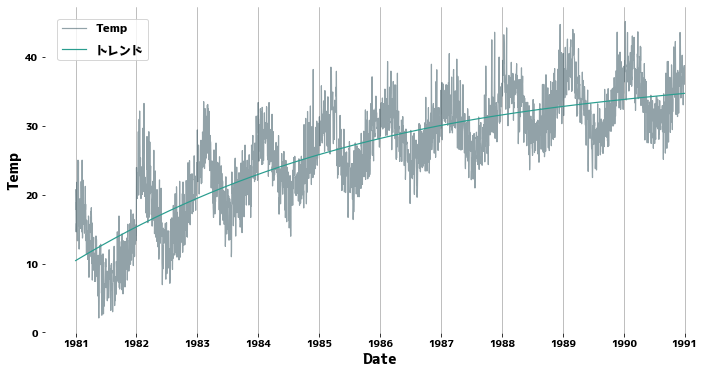Check Dataset
See what’s in the data
import datetime
import pandas as pd
import matplotlib.pyplot as plt
import numpy as np
import seaborn as sns
from scipy import stats
from statsmodels.tsa import stattools
Reading a dataset from a csv file
data = pd.read_csv("sample.csv")
data.head(10)
| Date | Temp | |
|---|---|---|
| 0 | 1981-01-01 | 20.7 |
| 1 | 1981-01-02 | 17.9 |
| 2 | 1981-01-03 | 18.8 |
| 3 | 1981-01-04 | 14.6 |
| 4 | 1981-01-05 | 15.8 |
| 5 | 1981-01-06 | 15.8 |
| 6 | 1981-01-07 | 15.8 |
| 7 | 1981-01-08 | 17.4 |
| 8 | 1981-01-09 | 21.8 |
| 9 | 1981-01-10 | 20.0 |
Set timestamp to datetime
The Date column is currently read as an Object type, i.e., a string. To treat it as a timestamp, use the following datetime — Basic Date and Time Types to convert it to a datetime type.
data["Date"] = data["Date"].apply(
lambda x: datetime.datetime.strptime(str(x), "%Y-%m-%d")
)
print(f"Date column dtype: {data['Date'].dtype}")
Date column dtype: datetime64[ns]
Get an overview of a time series
pandas.DataFrame.describe
To begin, we briefly review what the data looks like. We will use pandas.DataFrame.describe to check some simple statistics for the Temp column.
data.describe()
| Temp | |
|---|---|
| count | 3650.000000 |
| mean | 11.177753 |
| std | 4.071837 |
| min | 0.000000 |
| 25% | 8.300000 |
| 50% | 11.000000 |
| 75% | 14.000000 |
| max | 26.300000 |
Line graph
Use seaborn.lineplot to see what the cycle looks like.
plt.figure(figsize=(12, 6))
sns.lineplot(x=data["Date"], y=data["Temp"])
plt.ylabel("Temp")
plt.grid(axis="x")
plt.grid(axis="y", color="r", alpha=0.3)
plt.show()
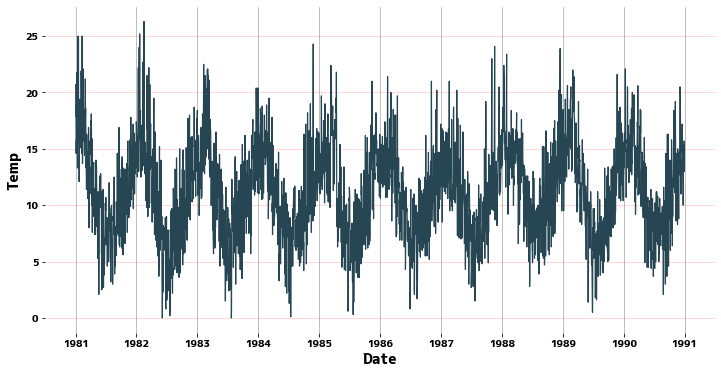
Histogram
plt.figure(figsize=(12, 6))
plt.hist(x=data["Temp"], rwidth=0.8)
plt.xlabel("Temp")
plt.ylabel("日数")
plt.grid(axis="y")
plt.show()
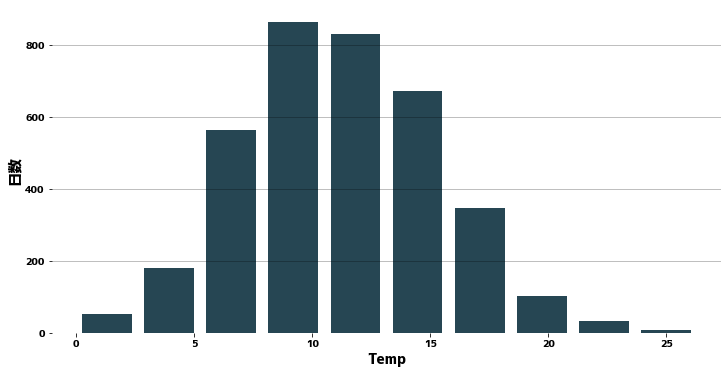
Autocorrelation and Cholerograms
Using pandas.plotting.autocorrelation_plot Check autocorrelation to check the periodicity of time series data. Roughly speaking, autocorrelation is a measure of how well a signal matches a time-shifted signal of itself, expressed as a function of the magnitude of the time shift.
plt.figure(figsize=(12, 6))
pd.plotting.autocorrelation_plot(data["Temp"])
plt.grid()
plt.axvline(x=365)
plt.xlabel("lag")
plt.ylabel("autocorrelation")
plt.show()
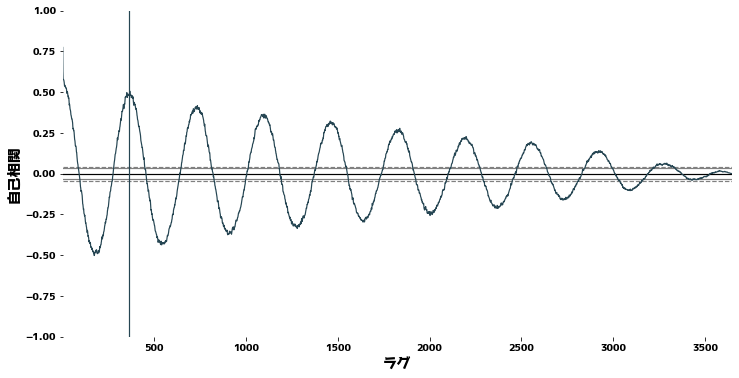
Unit Root Test
We check to see if the data are a unit root process. The Augmented Dickey-Fuller test is used to test the null hypothesis of a unit root process.
statsmodels.tsa.stattools.adfuller
stattools.adfuller(data["Temp"], autolag="AIC")
(-4.444804924611697,
0.00024708263003610177,
20,
3629,
{'1%': -3.4321532327220154,
'5%': -2.862336767636517,
'10%': -2.56719413172842},
16642.822304301197)
Checking the trend
The trend line is drawn by fitting a one-dimensional polynomial to the time series. Since the data in this case is almost trend-stationary, there is almost no trend.
numpy.poly1d — NumPy v1.22 Manual
def get_trend(timeseries, deg=3):
"""Create a trend line for time-series data
Args:
timeseries(pd.Series) : time-series data
Returns:
pd.Series: trend line
"""
x = list(range(len(timeseries)))
y = timeseries.values
coef = np.polyfit(x, y, deg)
trend = np.poly1d(coef)(x)
return pd.Series(data=trend, index=timeseries.index)
data["Trend"] = get_trend(data["Temp"])
# グラフをプロット
plt.figure(figsize=(12, 6))
sns.lineplot(x=data["Date"], y=data["Temp"], alpha=0.5, label="Temp")
sns.lineplot(x=data["Date"], y=data["Trend"], label="トレンド")
plt.grid(axis="x")
plt.legend()
plt.show()
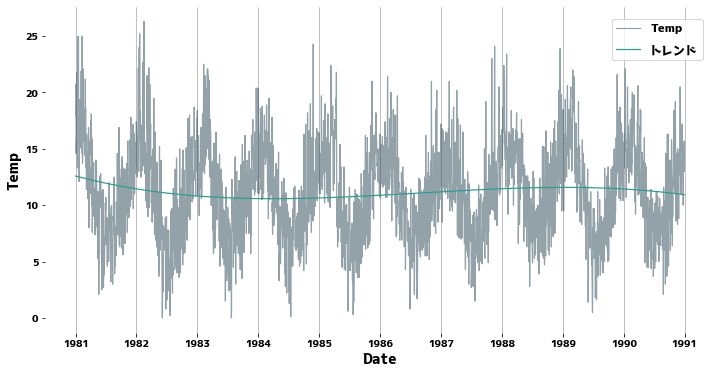
Supplement: If there is a clear trend
The green line is the trend line.
data_sub = data.copy()
data_sub["Temp"] = (
data_sub["Temp"] + np.log(data_sub["Date"].dt.year - 1980) * 10
) # Dummy Trends
data_sub["Trend"] = get_trend(data_sub["Temp"])
plt.figure(figsize=(12, 6))
sns.lineplot(x=data_sub["Date"], y=data_sub["Temp"], alpha=0.5, label="Temp")
sns.lineplot(x=data_sub["Date"], y=data_sub["Trend"], label="トレンド")
plt.grid(axis="x")
plt.legend()
plt.show()
